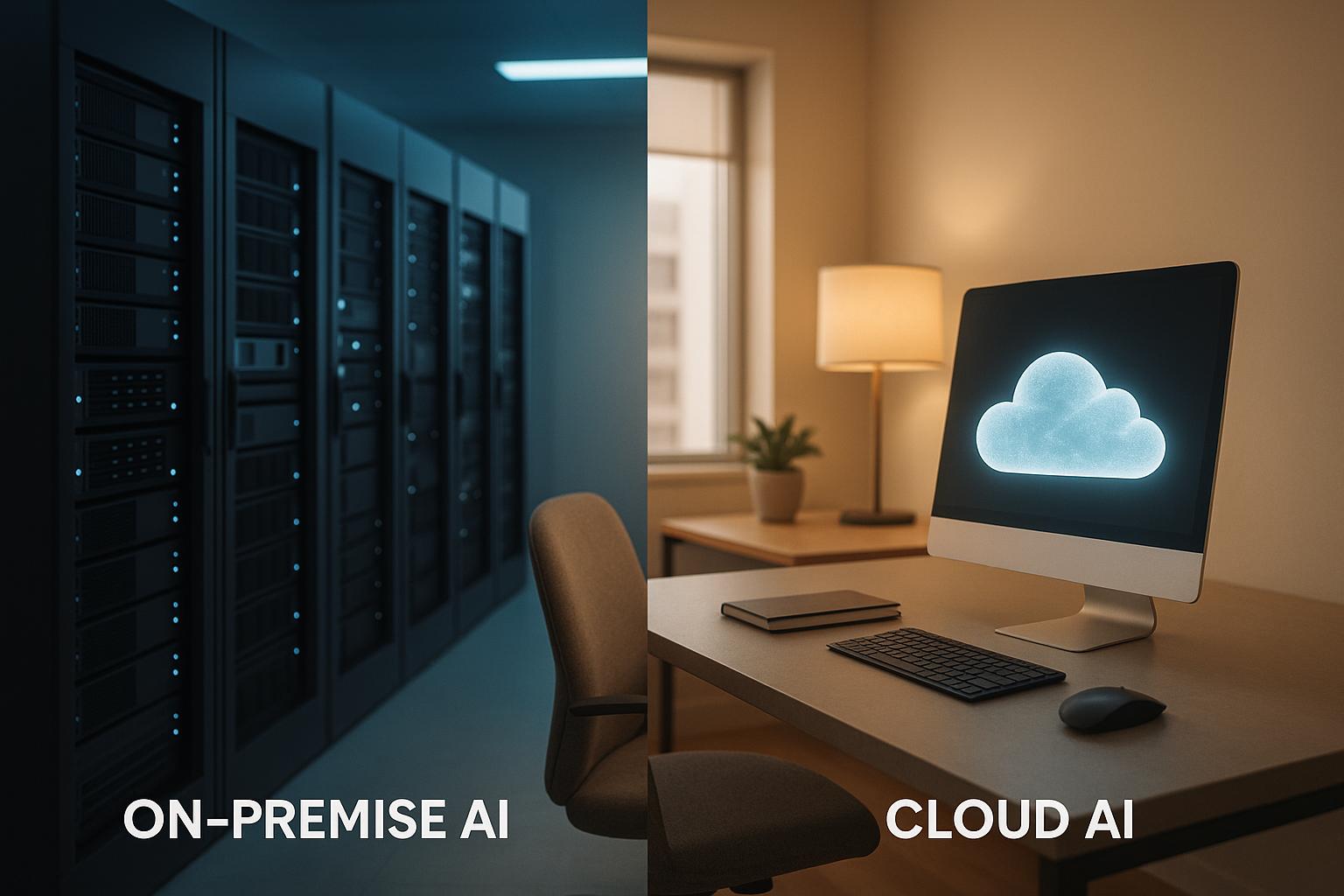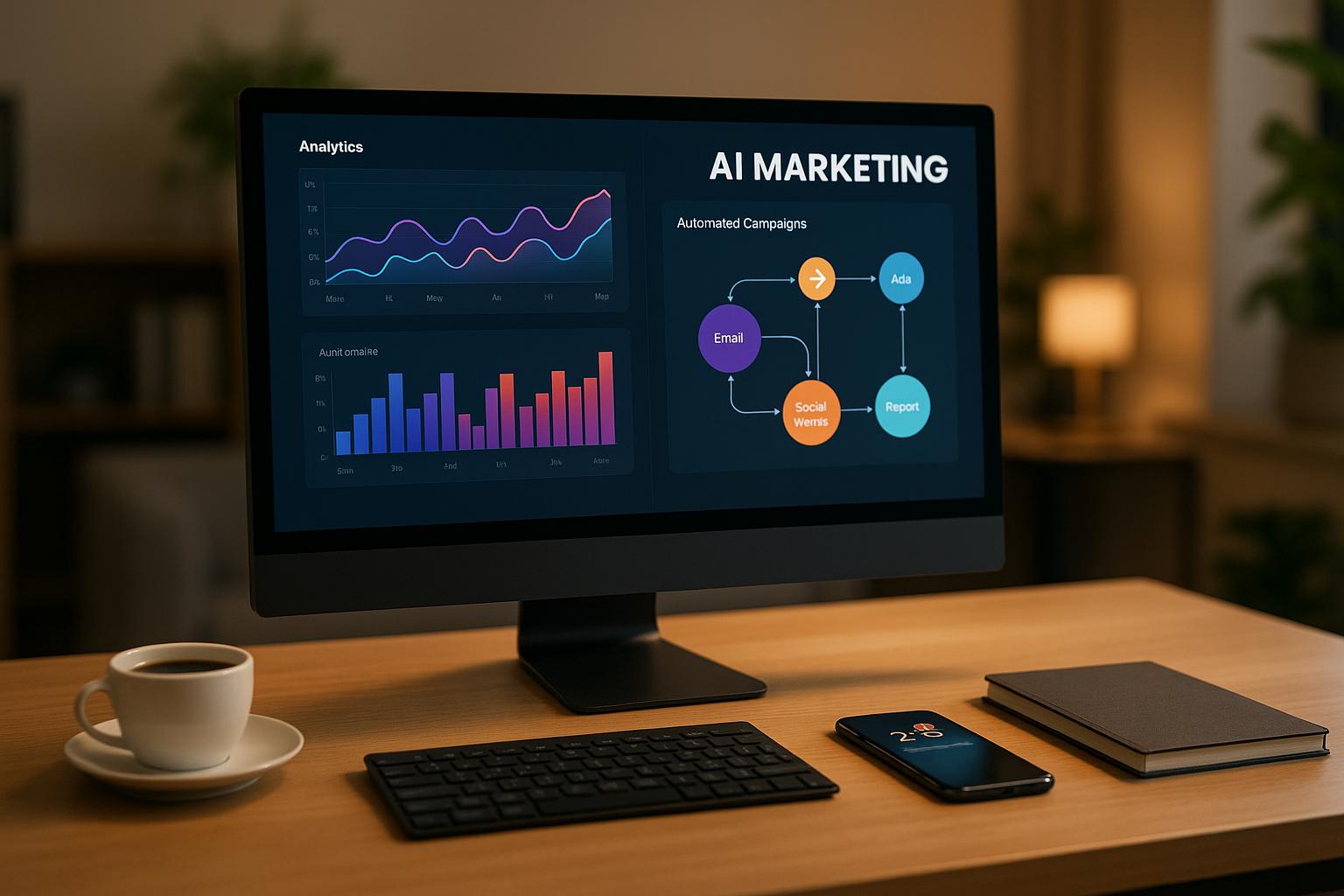Looking to save time and improve efficiency? Here are 8 AI automation tools that can handle repetitive tasks, simplify workflows, and boost productivity. Each tool caters to specific needs, from no-code platforms to advanced generative AI solutions. Here's a quick overview:
- FlowForma: No-code workflow automation with AI-powered Copilot and real-time analytics.
- Automation Anywhere: RPA platform with IQBot for unstructured data and scalable bot deployment.
- Appian: Low-code platform for process automation and real-time workflow analysis.
- Pega: AI-driven decision engine for large-scale automation and CRM integration.
- WorkFusion: Combines RPA and machine learning for intelligent document processing.
- Multimodal GenAI Agents: Processes text, images, and audio simultaneously for complex tasks.
- Nintex: Low-code platform for process mapping, document automation, and real-time analytics.
- Microsoft Power Automate: Cloud-based automation with AI Builder and cross-platform integration.
Quick Comparison:
| Tool | Key Features | Pricing | Best For |
|---|---|---|---|
| FlowForma | No-code, AI Copilot, real-time analytics | $2,180/month | Healthcare, construction |
| Automation Anywhere | RPA, IQBot, scalable bot deployment | Custom pricing | Enterprise-level automation |
| Appian | Low-code, process mining, case management | $75/user/month | Healthcare, finance |
| Pega | AI decisioning, CRM integration | Custom pricing | Large-scale workflows |
| WorkFusion | RPA, machine learning, document processing | Custom pricing | Banking, insurance |
| Multimodal GenAI | Text, image, audio processing | Contact for pricing | Cross-industry automation |
| Nintex | Process mapping, document automation | Custom pricing | Workflow automation |
| Microsoft Power Automate | AI Builder, UI/Cloud Flows, analytics | $15-$40/user/month | Microsoft ecosystem users |
These tools cater to businesses of all sizes, from startups to enterprises. Choose based on your workflow complexity, integration needs, and budget.
9 Best AI Automation Tools in 2025
1. FlowForma
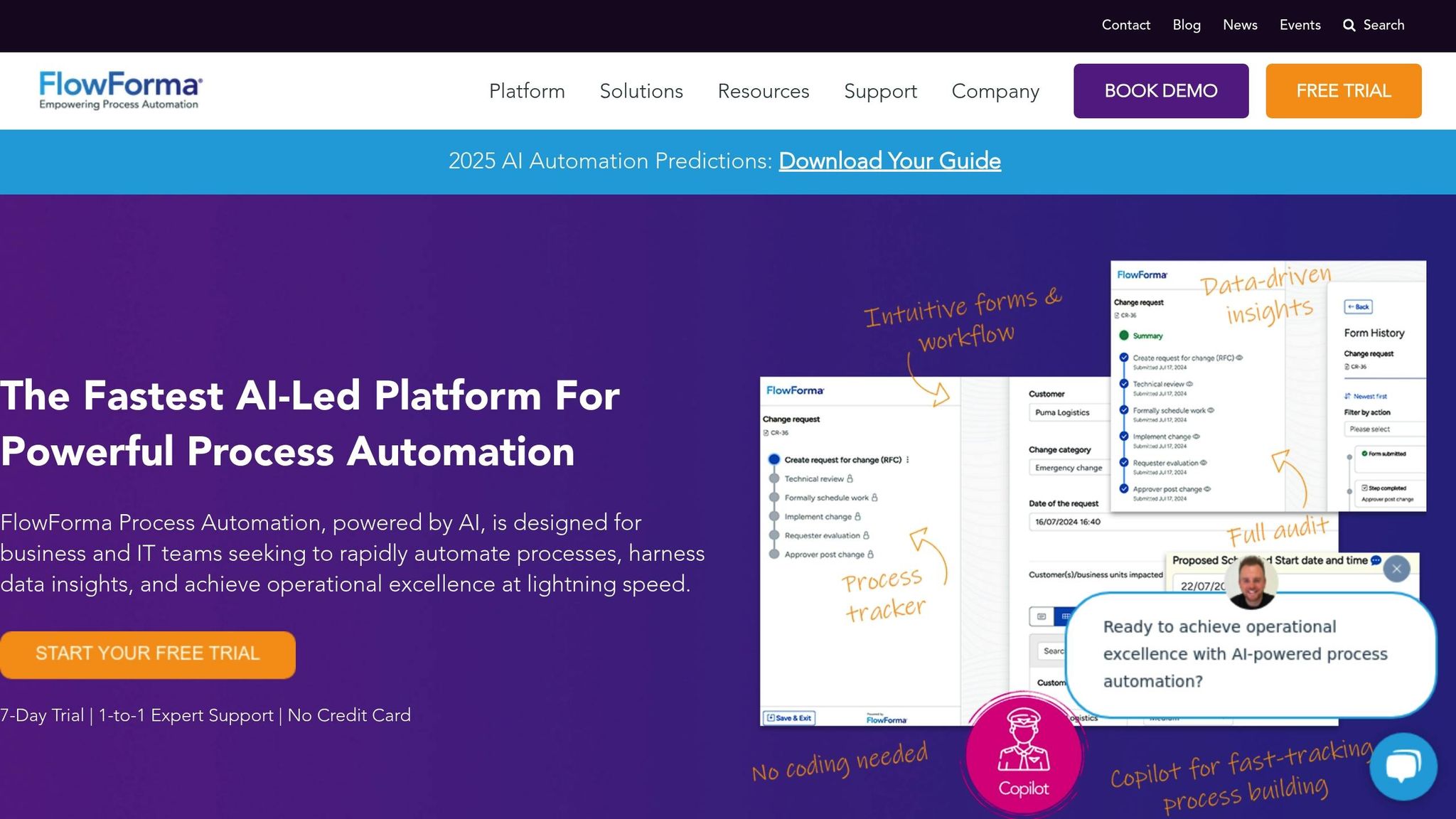
FlowForma is a no-code workflow automation tool designed to let businesses streamline processes without needing technical expertise. It allows users to independently create forms, design workflows, and manage documents - cutting down on reliance on IT teams.
One of its standout tools is the AI-powered Copilot, which uses natural language processing to transform simple commands into automated workflows. This makes setting up and managing processes more intuitive and accessible.
FlowForma also excels in system integration. It connects seamlessly with platforms like Microsoft 365, CRM systems, and ERP software, ensuring smooth data transfer across tools. This reduces manual data entry and ensures consistency across an organization’s tech stack.
Another helpful feature is AI Summarization, which condenses form responses into actionable insights. This makes it easier for decision-makers to quickly understand the data they’ve collected.
For teams focused on compliance and efficiency, FlowForma’s real-time analytics dashboard provides a clear view of workflow performance. It helps users spot bottlenecks and make informed adjustments to improve processes.
Key Features at a Glance:
| Feature Category | Capabilities |
|---|---|
| Core Automation | - No-code workflow design - Document generation - Form creation and management |
| AI Integration | - Copilot with natural language processing - AI summarization - Multi-language support |
| Enterprise Features | - Microsoft 365 integration - CRM/ERP connectivity - Real-time analytics |
FlowForma is priced at $2,180 per month, aimed at enterprises and SMEs looking to modernize their workflows. While the cost might seem steep, its ability to save time and reduce errors often makes it a worthwhile investment, especially for businesses managing complex processes.
The platform is particularly effective for industries with strict process requirements like construction, healthcare, and energy. Its real-time performance data feedback loop ensures processes are continuously optimized, helping organizations improve efficiency and stay ahead.
2. Automation Anywhere
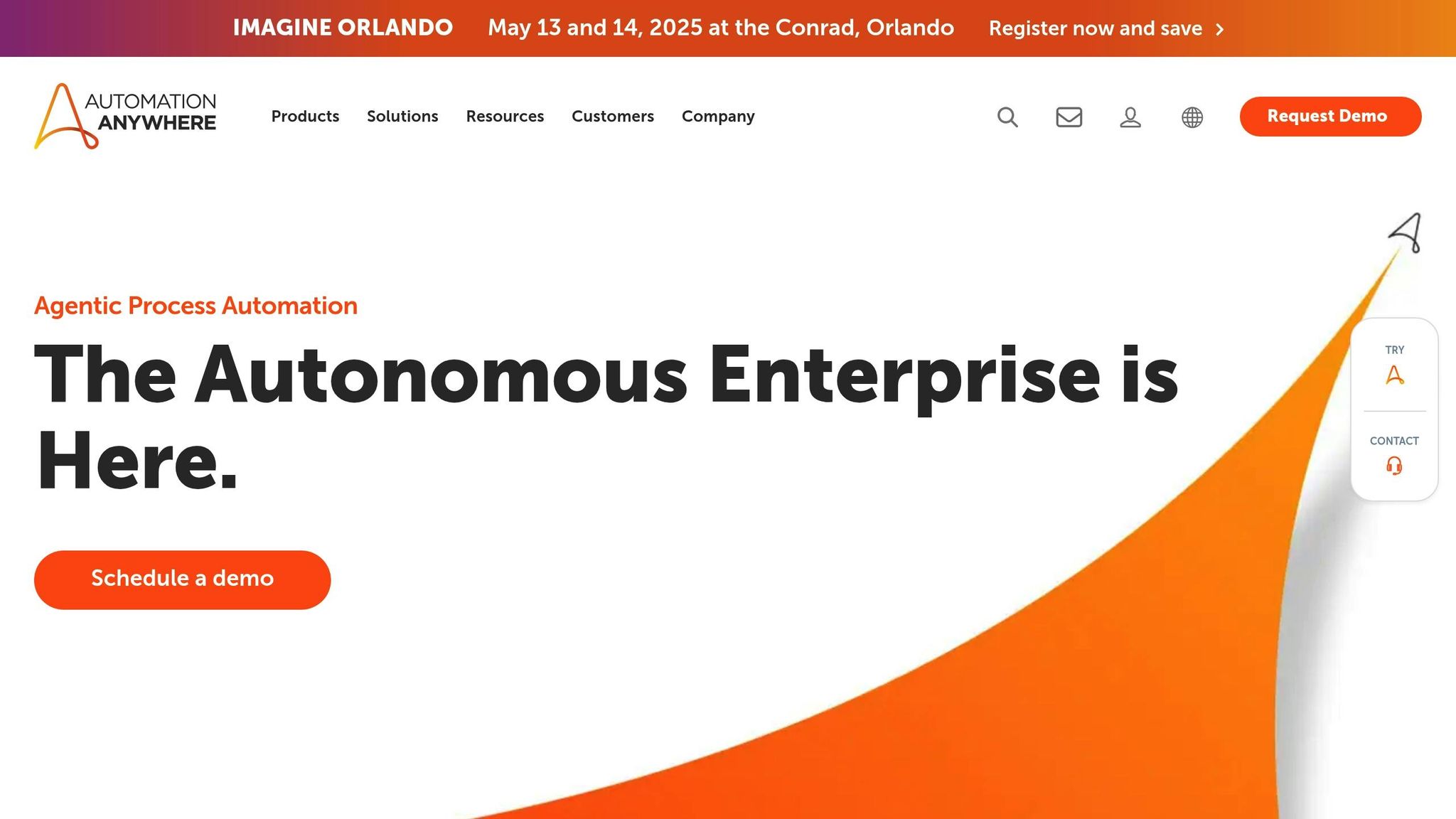
After exploring FlowForma's workflow automation, let's dive into Automation Anywhere, a top-tier RPA platform designed for enterprise-level automation needs.
Automation Anywhere stands out as a leader in robotic process automation (RPA), recognized by Gartner for its AI-driven capabilities. It focuses on automating repetitive tasks, helping enterprises modernize and streamline their workflows.
Its Bot Creator interface offers a drag-and-drop environment, making it user-friendly for both technical and non-technical users. Despite its simplicity, it provides the depth needed for handling complex, large-scale automation projects.
One standout feature is IQBot, which excels at processing unstructured data. This is especially helpful for organizations dealing with diverse document formats and data types. Meanwhile, BotFarm enables the deployment of thousands of bots, allowing businesses to scale their automation efforts as they grow.
Here’s an example of its impact: In 2020, the City of San Diego's finance department reported impressive results:
| Metric | Result |
|---|---|
| Manual Effort Reduction | 70% |
| Process Accuracy | Improved by 90% |
| ROI | 300% return in just three years |
The platform’s Control Room acts as a central management hub, ensuring smooth bot operation and strong security measures. It also provides predictive analytics, offering actionable insights to identify bottlenecks and uncover opportunities for optimization.
Automation Anywhere supports both cloud and on-premises setups, making it flexible for various IT environments. Its extensive partner network ensures smooth integration with existing systems. Pricing is tailored to each organization, and with proven ROI, it’s a compelling choice for enterprises aiming to scale their automation efforts. Additionally, its active community and detailed training resources help users get the most out of the platform.
According to MarketsandMarkets, the RPA market is expected to grow at a 33.6% CAGR between 2020 and 2027. With over 1,200 reviews and a 4.5-star rating on Gartner Peer Insights, Automation Anywhere combines ease of use, scalability, and advanced AI features, making it a powerful option for businesses looking to refine their workflow automation strategies.
3. Appian
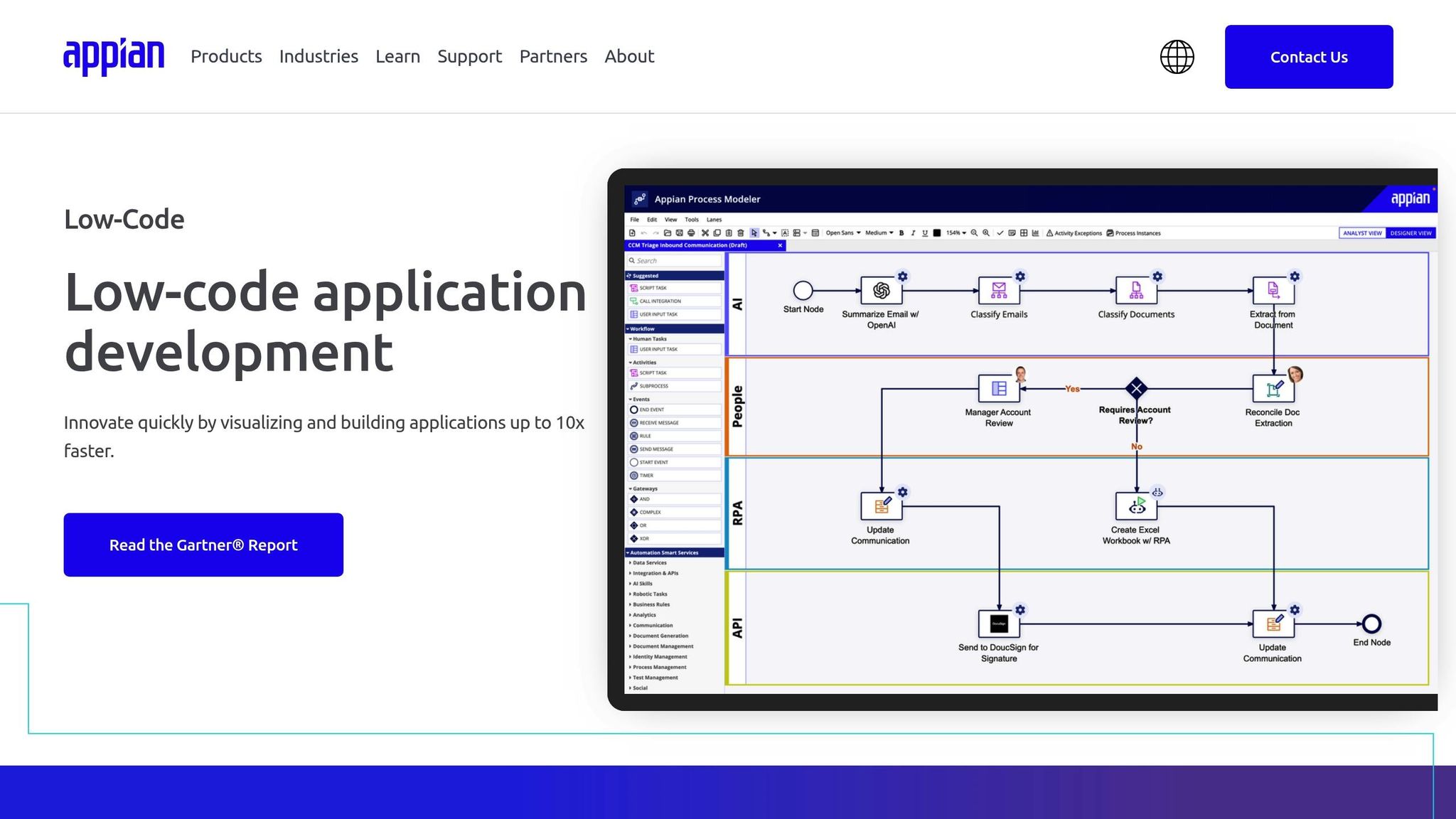
Appian is a low-code platform that blends AI-driven workflow automation with business process management tools. This section highlights its low-code capabilities and how it impacts businesses.
Appian's low-code development environment offers visual process modeling alongside AI-powered automation. Its algorithms analyze workflow data in real-time, striking a balance between automation and human input.
In the healthcare sector, Appian has reshaped patient care workflows. Forrester's 2020 analysis highlights the following results:
| Metric | Result |
|---|---|
| Development Time | 50% faster |
| Operational Costs | 30% lower |
| Process Efficiency | 71% better |
| Customer Satisfaction | 64% higher |
The platform integrates smoothly with CRM and ERP systems, driving efficiency across various industries. Features like data encryption, access controls, and detailed audit trails ensure compliance with security standards, further enhancing its appeal to enterprises.
Pricing begins at $75 per user per month. With over 1,600 organizations using Appian worldwide, it plays a key role in modern workflow automation. Its 4.5-star rating on Gartner Peer Insights, based on 240 reviews, highlights its reliability and consistent performance.
As the low-code development market is expected to grow to $45.5 billion by 2025 (with a CAGR of 24.3%), Appian is well-positioned to support organizations looking to modernize their workflows and embrace automation.
4. Pega
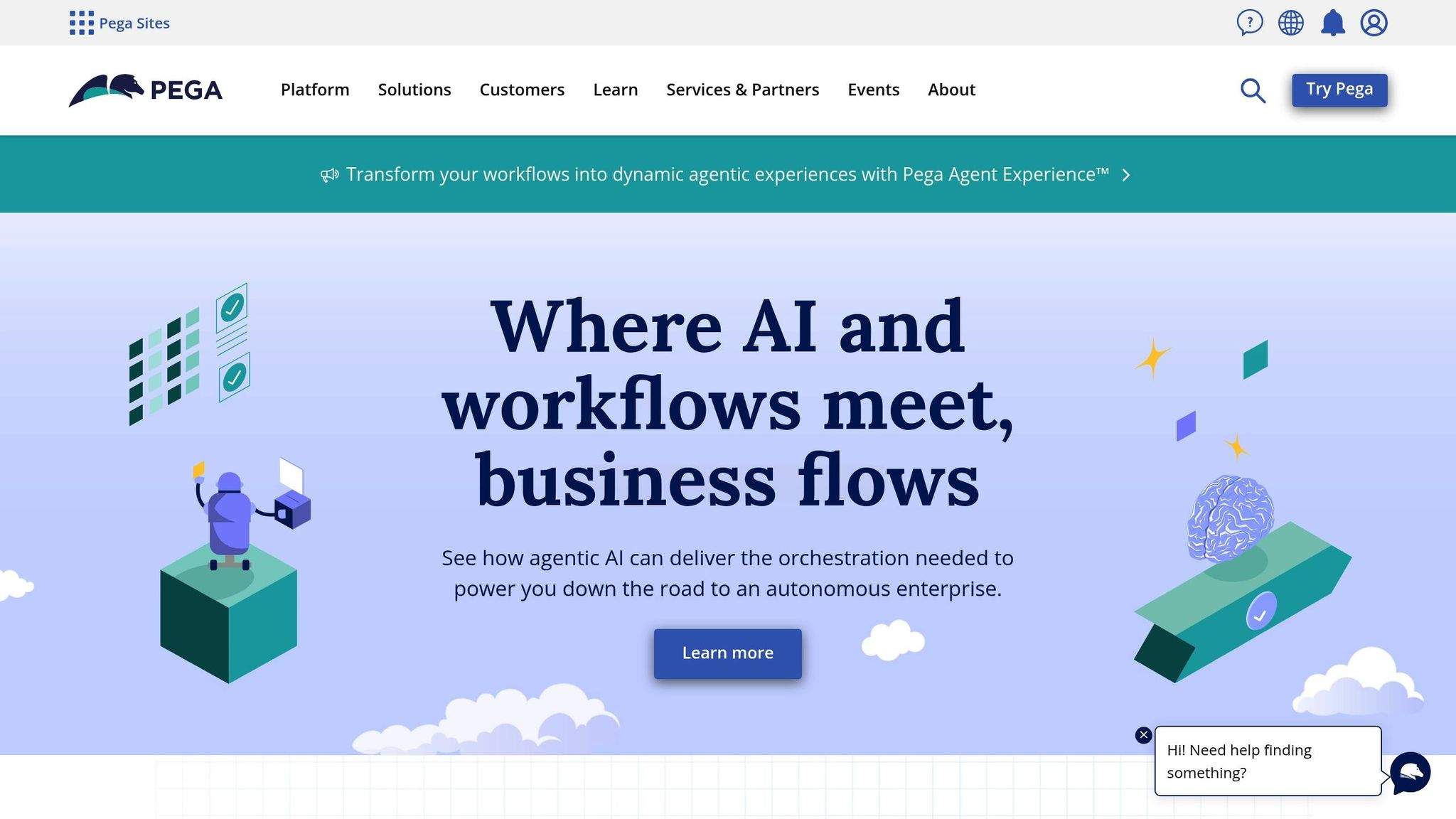
Pega is a platform designed to simplify business operations through AI-driven automation. Its decision engine can handle over 100 million decisions daily, making it a solid choice for automating complex workflows on a large scale (Pega Whitepaper, 2023).
For example, the Commonwealth Bank of Australia used Pega's tools in 2022 to automate over 100 business processes. This led to a 40% drop in manual processing time and a 25% cut in operational costs (Pega Case Studies, 2022).
Pega integrates with major systems like CRM and ERP, offering a low-code environment that allows users to tweak workflows without needing advanced technical expertise. At the same time, it ensures enterprise-grade security with features like advanced encryption and detailed access controls. Studies back up these benefits: A Forrester report found that Pega deployments often reduce manual processing time by 50% and cut costs by 30% (Forrester Study, 2022).
The platform also offers flexible pricing tailored to different organizational requirements. With a 4.5/5 rating on Gartner Peer Insights, users frequently highlight its strong security measures and compliance with standards like GDPR and HIPAA.
To help users get started, Pega provides training materials and a supportive community. Its continued focus on AI and machine learning ensures it remains a leading option for businesses seeking automation solutions.
5. WorkFusion
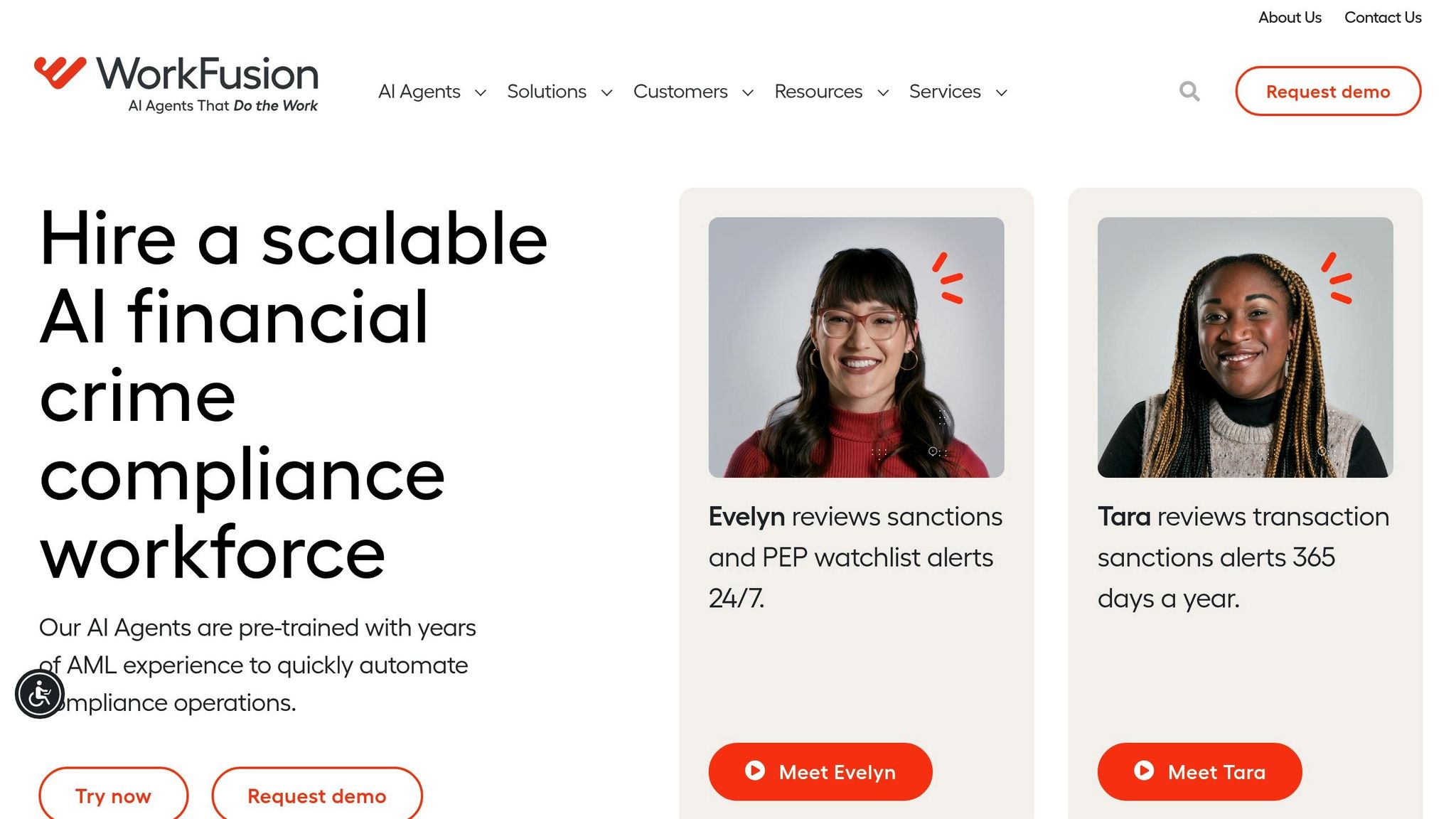
WorkFusion combines RPA with advanced machine learning to help businesses lower costs and boost productivity. According to Forrester (2022), it can cut operational costs by up to 50% and increase productivity by 30%. No wonder it's gaining traction across various industries.
For example, Deutsche Bank uses WorkFusion to overhaul its document processing. The platform handles unstructured data with precision, and its machine learning algorithms get smarter over time through user interactions.
WorkFusion is built to handle complex workflows while ensuring enterprise-level security and compliance with regulations like GDPR and HIPAA. One financial services company automated 80% of its manual data extraction, slashing costs by 40%. On Gartner Peer Insights, WorkFusion holds a 4.5-star rating based on 22 verified reviews.
The platform is user-friendly, catering to both technical and non-technical users with features like:
| Feature | Benefit |
|---|---|
| Low-code Interface | Simplifies workflow creation without requiring advanced programming skills |
| Real-time Analytics | Offers instant insights into performance and bottlenecks |
| Adaptive Learning | Enhances automation accuracy through machine learning |
| Multi-source Integration | Easily connects with existing systems and data |
These tools, paired with its automation strengths, make WorkFusion a flexible option for businesses. It operates on a subscription model and provides extensive support, including training and implementation help. Recognized by both Gartner and Forrester, WorkFusion continues to solidify its reputation as a top-tier automation solution for streamlining operations.
sbb-itb-212c9ea
6. Multimodal GenAI Agents
Multimodal GenAI Agents are a major step forward in AI automation, capable of processing multiple types of data - like text, images, and audio - all at the same time. Unlike older, single-purpose tools, these agents can interpret context across different formats and adjust their responses based on the situation.
Their strength lies in handling complex, interconnected tasks. For example, in customer service, they can analyze incoming messages, craft appropriate responses, and even generate documentation - all while learning from each interaction to perform better over time.
Here’s a quick breakdown of their core strengths:
| Capability | Function | Business Impact |
|---|---|---|
| Cross-modal Processing | Manages text, images, and audio simultaneously | Cuts down the need for multiple tools |
| Adaptive Learning | Learns and improves through user interactions | Reduces errors over time |
| Intelligent Routing | Sends complex issues to human operators | Balances efficiency with quality assurance |
An important feature of these agents is their safeguards for human oversight. While they can handle routine tasks on their own, they’re designed to flag more complicated decisions for human review, ensuring accuracy and accountability.
These agents also integrate smoothly with existing business systems using APIs and data-sharing protocols. This makes it easy to connect them with other automation tools, like RPA platforms or BPM systems, to create a more streamlined workflow.
Tips for Implementation:
- Data Integration: Ensure the agent connects seamlessly with your existing systems and data sources.
- Customized Training: Tailor the agent to recognize patterns specific to your industry.
- Performance Tracking: Regularly monitor its efficiency and identify areas for improvement.
However, it’s crucial to address data privacy and security concerns. Organizations must set clear rules for handling data and ensure compliance with regulations like GDPR and HIPAA.
As technology advances, these agents are becoming even more capable. Developments in deep learning and natural language processing are paving the way for enhanced collaboration between humans and AI. They’re also expanding into areas like IoT and edge computing, making them a valuable addition to automation ecosystems. This progress complements other tools like Nintex, pushing the boundaries of what automation can achieve.
7. Nintex
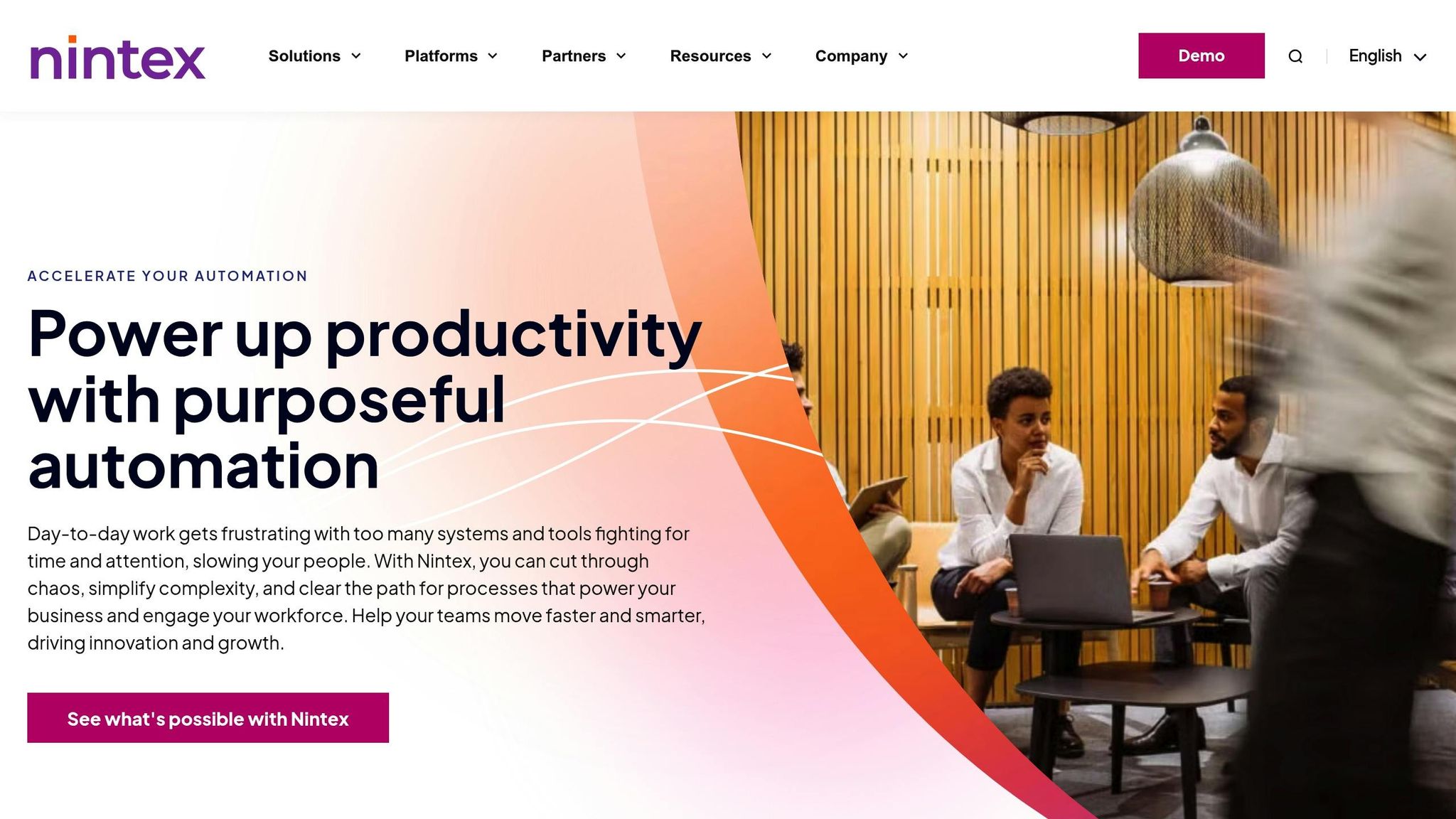
Nintex is a workflow automation platform designed to simplify complex processes. Its low-code approach allows both tech-savvy and non-technical users to quickly implement automated solutions, making it an appealing choice for teams across an organization.
The platform integrates seamlessly with major enterprise tools like Microsoft 365, SharePoint, and Salesforce. This connectivity helps break down data silos and reduces the need for manual tasks, creating a more streamlined and efficient workflow.
| Feature | Business Impact | Example Use Case |
|---|---|---|
| Document Automation | Cuts manual effort by 80% | Automating claims processing in insurance |
| Workflow Design | Speeds up processes by 75% | Digital permit approvals in government |
| Real-time Analytics | Enables data-driven decisions | Tracking performance and identifying bottlenecks |
These capabilities deliver real results. For example, the City of San Diego revamped its permitting system with Nintex, cutting processing time by 75% and improving customer satisfaction by 90%.
Nintex also prioritizes security and compliance. Features like access controls, audit trails, and secure data handling make it well-suited for industries with strict regulations, such as healthcare and finance.
Key Performance Metrics
- Companies using Nintex report an average ROI of 176% over three years.
- In 2022, customer use of Nintex’s RPA tools increased by 30%.
These numbers highlight the platform's effectiveness. While pricing varies and requires consultation, its flexibility and proven ROI make it a worthwhile investment for businesses of all sizes.
Nintex’s reputation speaks for itself, with a 4.5-star rating on Gartner Peer Insights and recognition as a Leader in the 2022 Gartner Magic Quadrant for Process Automation.
To get the most out of Nintex, businesses should focus on automating high-impact processes and use its analytics tools to refine and improve workflows over time. Its scalability makes it a strong option for companies looking to boost efficiency as they grow.
8. Microsoft Power Automate
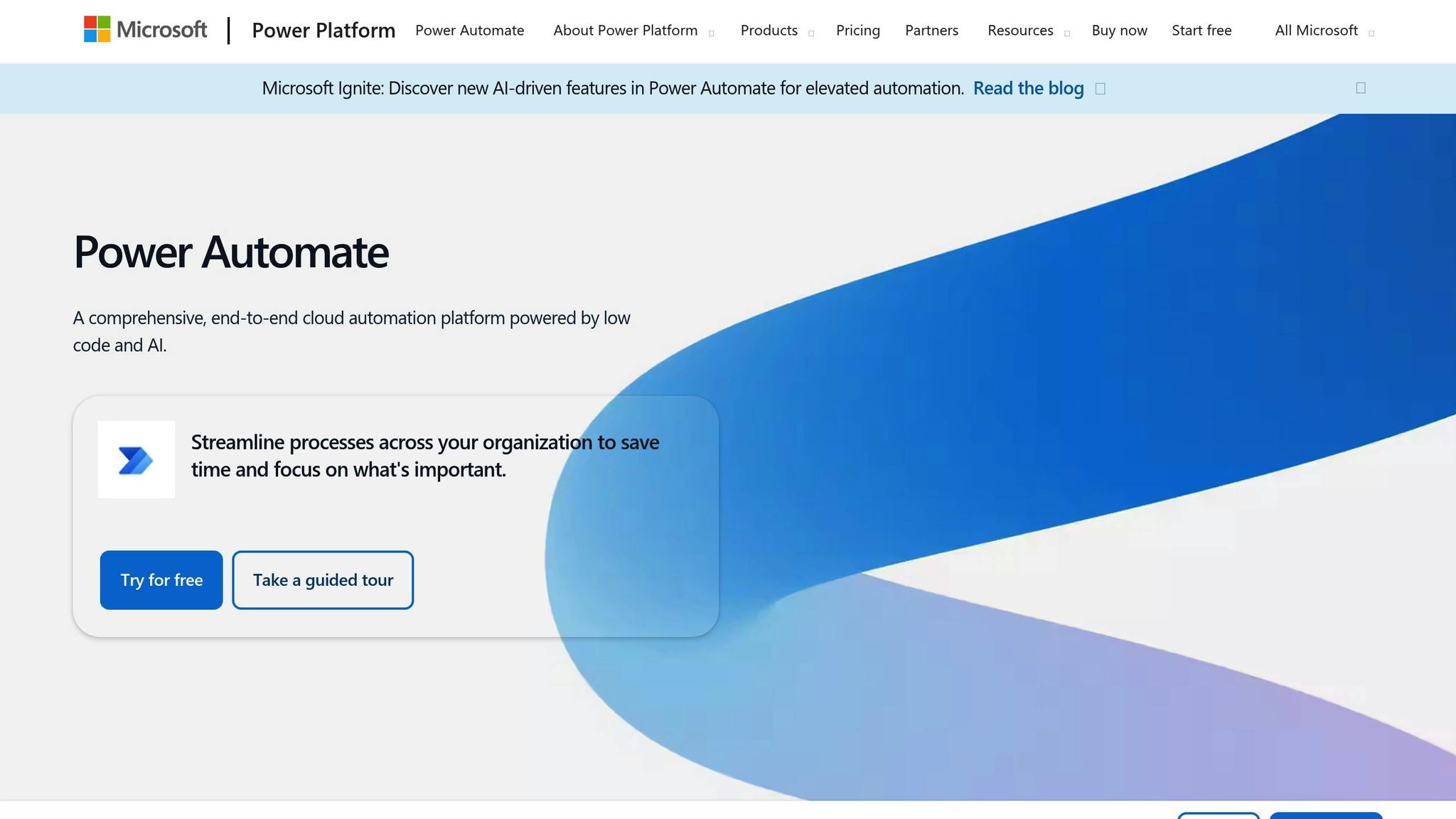
Microsoft Power Automate, previously called Microsoft Flow, is a cloud-based tool designed to help businesses - especially those using Microsoft - automate their workflows. Here's how it simplifies processes and delivers measurable results.
The platform offers features like AI tools for document automation, UI Flows for handling older systems, and Cloud Flows for integrating across applications. Real-time analytics also ensure continuous improvements driven by data.
| Feature | Capability | Business Impact |
|---|---|---|
| AI Builder | Automates document handling | Improves efficiency in managing documents |
| UI Flows | Robotic Process Automation | Automates tasks on outdated systems |
| Cloud Flows | Cross-platform automation | Connects various applications seamlessly |
| Process Analytics | Real-time monitoring | Enables data-driven process improvements |
According to a Forrester study, businesses using Power Automate can achieve a 362% ROI within three years, with many seeing payback in under six months[1].
Pricing starts at $15 per user per month, with an advanced option (including attended RPA) available for $40 per user per month.
Power Automate also prioritizes security and compliance, meeting standards like GDPR and HIPAA. It ensures data protection through encryption and detailed access controls.
Its integration with the Microsoft Power Platform takes automation further. By combining Power Automate with tools like Power Apps and Power BI, businesses can create comprehensive solutions that streamline processes and deliver smarter insights.
This cohesive Microsoft ecosystem enables businesses to revamp workflows by following these steps:
- Focus on processes with the highest impact
- Leverage pre-built templates
- Track performance through analytics
- Expand automation to handle more complex tasks
Tool Features and Pricing Chart
Here's a quick breakdown of each tool's main features, pricing, typical use cases, and system requirements to complement the detailed reviews above.
| Tool | Key Features | Pricing | Common Uses | System Requirements |
|---|---|---|---|---|
| FlowForma | • AI-powered form creation • No-code workflow design • Real-time analytics • Document generation |
Custom pricing | Healthcare, construction, energy sectors | Microsoft 365 integration |
| Automation Anywhere | • Cloud-based RPA • Process discovery • AI/ML capabilities |
Custom pricing | Financial services, IT automation | Cloud-based; Windows/Mac compatible |
| Appian | • Low-code platform • Process mining • Case management |
Starting at $75/user/month | Healthcare, financial services, government | Web-based; Cloud or on-premises |
| Pega | • CRM integration • AI decisioning • Digital process automation |
Custom pricing | Banking, insurance, telecommunications | Cloud or on-premises deployment |
| WorkFusion | • Intelligent document processing • Pre-built automations • AI/ML capabilities |
Custom pricing | Banking, insurance, healthcare | Cloud-based infrastructure |
| Multimodal GenAI Agents | • Natural language processing • Multi-platform integration • Advanced AI capabilities |
Contact for pricing | Cross-industry automation | API integration required |
| Nintex | • Process mapping • Document automation |
Custom pricing | Workflow automation | Microsoft 365, cloud, or on-premises |
| Microsoft Power Automate | • AI Builder • UI + Cloud Flows • Process Analytics |
$15/user/month (basic) $40/user/month (with RPA) |
Cross-platform workflow automation | Microsoft ecosystem integration |
Key Points to Consider:
- Pricing depends on the scale of deployment and the features you need.
- Most tools offer trial versions, so you can test them before committing.
When choosing the right tool, focus on factors like integration, scalability, total costs (including implementation and training), security, and the level of expertise required. This comparison lays the groundwork for the practical advice shared in our FAQs.
Final Notes
When choosing an AI automation tool, focus on how well it aligns with your organization's specific needs. Here's a breakdown to guide your decision:
- Small Businesses and Startups: Look for affordable, easy-to-implement tools that don't require extensive coding knowledge. Microsoft Power Automate is a solid choice for those already using Microsoft products, while FlowForma works well for teams without dedicated IT support.
- Mid-Sized Organizations: Opt for scalable platforms that balance advanced features with cost. Appian offers a low-code platform that simplifies deployment and handles more complex workflows effectively.
- Enterprises: Prioritize tools that can handle large-scale, multi-department workflows. Solutions like Pega and WorkFusion provide advanced AI features to manage intricate processes efficiently.
Once you've chosen a tool, follow this practical framework to ensure success:
- Assessment: Review your workflows and pinpoint repetitive, high-volume tasks that could benefit from automation.
- Pilot: Test the tool with a small-scale rollout to validate its effectiveness.
- Integration: Make sure the tool integrates smoothly with your existing systems.
Key factors for success:
- Choose tools that offer strong training and support resources.
- Ensure compliance with your industry's regulations.
- Check that the tool can scale as your organization grows.
- Account for all costs, including implementation and training - not just the upfront price.
Remember, the most expensive tool isn't always the best fit. Many organizations find success with mid-range options that strike the right balance between functionality and ease of use. The goal is to match the tool's capabilities with your workflow requirements and budget.
FAQs
What is the best AI tool for productivity?
The best AI tool for productivity depends on your organization's specific needs, size, and technical setup.
For instance, Microsoft Power Automate demonstrated measurable improvements in 2023. A healthcare organization reduced processing time by 40% and improved data accuracy by 25% (Microsoft Power Automate Case Studies, 2023). Similarly, FlowForma, featuring a no-code AI-powered Copilot (starting at $2,180/month), enabled a construction company to reduce manual work by 75% and improve process accuracy by 90% (FlowForma Case Studies, 2024). These examples highlight the importance of aligning tools with your goals.
For businesses managing complex workflows, Automation Anywhere offers advanced RPA capabilities, enterprise-grade security, and extensive integration options.
When choosing a tool, consider these factors:
- How well it integrates with your current systems
- Its ability to scale as your business grows
- How easy it is for your team to use, based on their technical skills
- The availability of support and training resources
- The total cost, including setup and training

